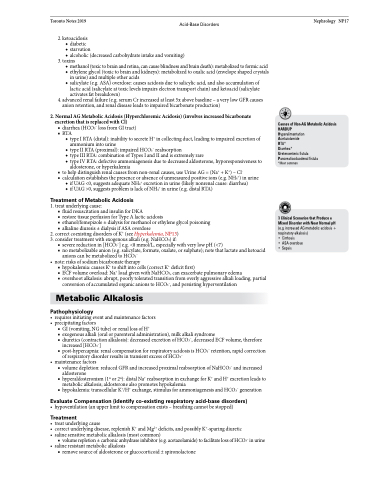Page 717 - TNFlipTest
P. 717
Toronto Notes 2019 Acid-Base Disorders
2. ketoacidosis ◆ diabetic
◆ starvation
◆ alcoholic (decreased carbohydrate intake and vomiting) 3. toxins
◆ methanol(toxictobrainandretina,cancauseblindnessandbraindeath):metabolizedtoformicacid
◆ ethylene glycol (toxic to brain and kidneys): metabolized to oxalic acid (envelope shaped crystals
in urine) and multiple other acids
◆ salicylate (e.g. ASA) overdose: causes acidosis due to salicylic acid, and also accumulation of
lactic acid (salicylate at toxic levels impairs electron transport chain) and ketoacid (salicylate
activates fat breakdown)
4. advanced renal failure (e.g. serum Cr increased at least 5x above baseline – a very low GFR causes
anion retention, and renal disease leads to impaired bicarbonate production)
2. Normal AG Metabolic Acidosis (Hyperchloremic Acidosis) (involves increased bicarbonate excretion that is replaced with Cl)
■ diarrhea (HCO3– loss from GI tract) ■ RTA
◆ type I RTA (distal): inability to secrete H+ in collecting duct, leading to impaired excretion of ammonium into urine
◆ type II RTA (proximal): impaired HCO3– reabsorption
◆ type III RTA: combination of Types I and II and is extremely rare
◆ type IV RTA: defective ammoniagenesis due to decreased aldosterone, hyporesponsiveness to
aldosterone, or hyperkalemia
■ to help distinguish renal causes from non-renal causes, use Urine AG = (Na+ + K+) – Cl-
■ calculation establishes the presence or absence of unmeasured positive ions (e.g. NH4+) in urine
◆ if UAG <0, suggests adequate NH4+ excretion in urine (likely nonrenal cause: diarrhea) ◆ if UAG >0, suggests problem is lack of NH4+ in urine (e.g. distal RTA)
Treatment of Metabolic Acidosis
1. treat underlying cause:
■ fluid resuscitation and insulin for DKA
■ restore tissue perfusion for Type A lactic acidosis
■ ethanol/fomepizole ± dialysis for methanol or ethylene glycol poisoning ■ alkaline diuresis ± dialysis if ASA overdose
2. correct coexisting disorders of K+ (see Hyperkalemia, NP13) 3. consider treatment with exogenous alkali (e.g. NaHCO3) if:
■ severe reduction in [HCO3–] e.g. <8 mmol/L, especially with very low pH (<7)
■ no metabolizable anion (e.g. salicylate, formate, oxalate, or sulphate); note that lactate and ketoacid
anions can be metabolized to HCO3– • note:risksofsodiumbicarbonatetherapy
■ hypokalemia: causes K+ to shift into cells (correct K+ deficit first)
■ ECF volume overload: Na+ load given with NaHCO3, can exacerbate pulmonary edema
■ overshoot alkalosis: abrupt, poorly tolerated transition from overly aggressive alkali loading, partial
conversion of accumulated organic anions to HCO3–, and persisting hyperventilation
Metabolic Alkalosis
Pathophysiology
• requiresinitiatingeventandmaintenancefactors • precipitatingfactors
■ GI (vomiting, NG tube) or renal loss of H+
■ exogenous alkali (oral or parenteral administration), milk alkali syndrome
■ diuretics (contraction alkalosis): decreased excretion of HCO3–, decreased ECF volume, therefore
increased [HCO3–]
■ post-hypercapnia: renal compensation for respiratory acidosis is HCO3– retention, rapid correction
of respiratory disorder results in transient excess of HCO3– • maintenancefactors
■ volume depletion: reduced GFR and increased proximal reabsorption of NaHCO3– and increased aldosterone
■ hyperaldosteronism (1o or 2o): distal Na+ reabsorption in exchange for K+ and H+ excretion leads to metabolic alkalosis; aldosterone also promotes hypokalemia
■ hypokalemia: transcellular K+/H+ exchange, stimulus for ammoniagenesis and HCO3– generation
Evaluate Compensation (identify co-existing respiratory acid-base disorders)
• hypoventilation(anupperlimittocompensationexists–breathingcannotbestopped)
Treatment
• treatunderlyingcause
• correct underlying disease, replenish K+ and Mg2+ deficits, and possibly K+-sparing diuretic • salinesensitivemetabolicalkalosis(mostcommon)
■ volume repletion ± carbonic anhydrase inhibitor (e.g. acetazolamide) to facilitate loss of HCO3– in urine • salineresistantmetabolicalkalosis
Nephrology NP17
Causes of Non-AG Metabolic Acidosis HARDUP
Hyperalimentation
Acetazolamide
RTA*
Diarrhea*
Ureteroenteric fistula Pancreaticoduodenal fistula *Most common
3 Clinical Scenarios that Produce a Mixed Disorder with Near Normal pH (e.g. increased AG metabolic acidosis + respiratory alkalosis)
• Cirrhosis
• ASA overdose • Sepsis
■ remove source of aldosterone or glucocorticoid ± spironolactone


